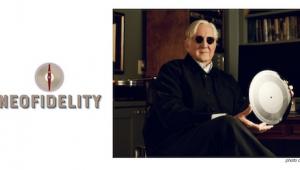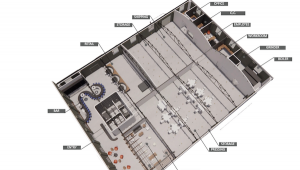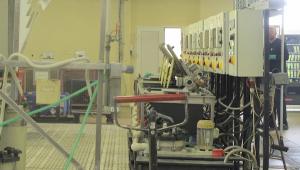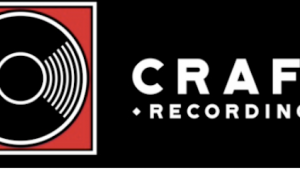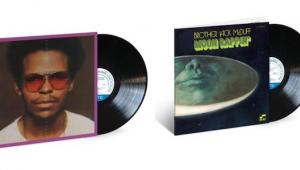With the lowest price of this series being $25,400, these are not exactly a bargain. I though with these new iterations that the price would come down from his initial offering. It did, but not by much. These tone arms may sound good but are really in the stratosphere price wise compared with other really excellent arms.
SAT (Swedish Analog Technologies) Begins Delivering Four New Pickup Arms

Both 9" models share the original SAT arm's mounting interface, geometry and external dimensions and therefore can be "drop in" replacements for those wishing to move to the new arms. The two longer arms are obviously not "drop in" replacements.
The more affordable LM series brings the original's performance profile to vinyl enthusiasts thanks to more efficient production processes and different materials that allow for less complex assembly techniques. The CF1 series expands and improves upon what the original SAT Pickup Arm achieved and is said to provide across the performance spectrum improvements mechanically and sonically.
The LM and CF1 series incorporate different arm tubes and head shells and feature different small yoke designs and bearings. Materials differ as well. The more costly CF1 arms' pillars and yokes are of stainless steel. The LM's are of lighter weight aluminum, which make them more appropriate for suspended 'tables that have no means of weight distribution compensation.
A new hybrid carbon fiber-aluminum head shell design for both series improves coupling rigidity. The more costly CF1 head shells use a higher grade of carbon fiber, along with an extended bonding area and higher mass.
Both new series feature newly developed arm tubes that no longer feature an outer polymer damping sleeve. The carbon fiber is now exposed across the arm's entire length. The one-piece construction extends from the headshell to the rear stem. An aluminum insert at the front provides a precision head shell interface that produces extremely smooth rotation for fine azimuth adjustments and solid clamping.

(LM-09 on left, CF1-09 on right)

(LM-09)

(CF1-09)
The arm tubes of all models have been entirely designed by SAT and made specifically for these arms using carbon fibre-epoxy pre-preg (pre-impregnated fabrics). The carbon fibre plies are stacked in a specific sequence and laid in different directions to provide the stiffness required by the design. Once the tubes have been cured under pressure and heated in an autoclave, they are CNC machined to a tapered profile. In this process, a precision lathe tool cuts the different plies. Different patterns may appear when plies with different orientations are exposed. It is completely normal for every tube to have a slightly different and unique pattern as the plies are hand-laid and are very thin.
The LM series uses the original SAT arm's grade of carbon fiber, though this time in a different laminate and geometry. The CF1 series benefits from a higher grade of carbon fibre in a specific laminate for these arms, with a bigger diameter and cross section for increased rigidity. The differences in material and size are reflected in the first natural resonance frequency of the arm tubes: 4.030Hz for CF1-09 and 3.550Hz for LM-09. Both are extremely high values with the CF1 arm having a significant advantage.
A new small yoke design houses new bearings for the movement in the vertical plane that are pre-loaded during manufacturing and then sealed. They will keep their pre-load and extremely low and even friction characteristics throughout the arms’ life; they are not user-adjustable. This new bearing system is stiffer and much more robust than the previous design. This design is said to completely eliminate any risk of damaging the bearings during shipment or handling under normal conditions.. The small yoke of the CF1 arms is more massive and the bearings are stiffer than in the LM models.
The LM and CF1 series share the same horizontal bearing design. These bearings are protected during shipment with a “transport bearing” that is replaced by a “playback bearing” during installation of the arm. The proper pre-load of the bearings is applied with a newly developed tool that allows the end- user to easily perform the operation; its design eliminates the risk of overloading the bearings.
Both the CF1 and LM series of arms share the same adjustment capabilities: azimuth via rotating headshell and with reference markings, height adjustment via knurled knob with a calibrated scale that can be operated during playback and locked, skating compensation with low-friction pulley, and VTF via a main counterweight, two locking nuts of different mass and a fine-tuning VTF screw. Special attention has been paid to provide rigid coupling between all components. The arm base, main counterweight and headshell use clamping features instead of set screws, with very tight tolerances for precise operation and even contact profile.
The 9” and 12” versions of each series share the same arm geometry as follows:
SAT 9 inch geometry:
Mounting distance : 212,2mm
Overhang : 22,8mm
Offset angle : 26,1 ̊
Innermost groove radius : 75mm
Outermost groove radius : 143mm
Nominal linear offset : 103,4mm
SAT 12 inch geometry:
Mounting distance : 280mm
Overhang : 17,6mm
Offset angle : 20.3 ̊
Innermost groove radius : 75mm
Outermost groove radius : 143mm
Nominal linear offset : 103.4mm
This paper explains why the designer Marc Gomez chose to design the original SAT Pickup Arm as a 9 inch model instead of a 12 inch one. After three years of production, and taking advantage of the launch of the new CF1 and LM series of arms, he decided to add a 12 inch version for each of the lines. This decision was driven by the request from some of the existing owners to be able to have an additional SAT arm that could be mounted on a position or a turntable where a shorter model wouldn’t fit; he also wanted to give consumers who prefer 12" arms the opportunity to experience SAT performance.
Gomez says that both the LM-12 and CF1-12 models have a consistent different sound when compared to their 9 inch siblings. It all can be explained by the physics of their design and how they interact with the cartridges. At the same time he says the original SAT Pickup Arm and all four new models share a common sonic identity, with very high resolution, low distortion and precise transient response, at the highest levels available today.
Retail prices in the US:
LM-09 : 25.400 USD
LM-12 : 29.000 USD
CF1-09 : 48.000 USD
CF1-12 : 53.000 USD
- Log in or register to post comments


My casual observation with audio is that production practices that scale supply have not reduced costs. I've casually looked at prices of products over years that should have benefited from reduced production cost of parts and they roughly pace inflation. This is a unfair assertion for really bespoke products where there's really no price discovery and the premium over manufacturing costs - aka the intellectual property and R&D costs - are just completely undiscoverable. They become whimsical and highly subjective. I can't say what a $20k premium over, say, a VPI 3D arm should sound like, except that it really comes down to how important that incremental benefit is and what $20k is worth. That number is roughly the annual income for a US family to hit the poverty line. For others it's the residual tax due on an already taxed annual bonus. Being a trained erstwhile scientist, I really struggle with what "new" technology can be applied to tonearm production. The geometries for these types of arms is fixed and known. What's left? Damping?

If I'd spent $30K on the original version of the SAT arm, I think I'd be more than a little nonplussed to learn that "This new bearing system is stiffer and much more robust than the previous design"--among other things. I understand that the constant urge to improve such an (apparently) advanced/leading edge design to capitalize on technological advances, new thinking, experience with the original design, etc. is the very core of the high end approach to music reproduction; however, when such an "apex product" is not merely tweaked (Mark II, etc.) but superseded, it always makes me wonder if the original design was thoroughly thought out. I don't want to pick on SAT here, as they're sure not unique in the high end's improved/new version sweepstakes.
But, jeeze, $48K for this iteration?
That said, my brief, non-critical exposure to the original SAT arm suggested that it was as excellent as Mr. Fremer said it was. Unfortunately--or fortunately, if you happen to be my spouse--a $30K arm upgrade was out of the question.

... a removable headshell? In that case, I'll be keeping my SME.

... removable headshells and no wire breaks?
Do you have to disconnect and reconnect the lead wires every time you go to swap headshells/cartridges?
Suppose you want to use an Ortofon SPU pick-up with the built-in headshell?

better machined, more complex mechanically, better finished, has a half a century of design behind it, and all for a fraction of the cost of SAT. That’s a lot more interesting to me. Why doesn’t SAT just charge $1,000,000.00 for it?

My current affordability for a great tonearm falls far short of the SAT level but I still love reading about them and am glad to hear of any innovation in analog playback that ups the ante as far as performance goes. Looking forward to some formal reviews Michael with much anticipation.
Rick

Or are these for the oligarch / petrobillionnaire types who drive up and down Knightsbridge in their Lamborghinis and Bugattis? When you have a $50mm penthouse at 1Hyde Park or One 57, what is another $250K to throw at an AV installer? That installer needs laughably expensive components so that his 20-25% commission adds up to some acceptable income. He cannot very well say, “Here is your perfect sounding Sonos system, in every room, components cost $3K, I will charge you only $50K for the installation.” But that fee looks a lot more reasonable on $250K.
Also people are funny when they are spending large sums. Even in a $5mm condo purchase, a $30K arm may not be a huge add-on. But once you move in, a week later, it does sound like a lot to spend. Why, you can buy a second car for that.
In any case my suspicion is, these inexplicably expensive components are mostly purchased by AV installers for their customers (who then probably play “Mozart for Babies” records they received as gifts for their kids, from Walmart). Specialty prices for the easy-come crowd.

Let me explain... There’s only 50-100 made per year. 99% are sold to showcase dealers worldwide, at a significant discount. We’re talking about 60%-75% off. Retail prices are purposely inflated for novelty. These dealers then use these tonearms at expo shows to wow broke audiophiles, who later purchase much cheaper products. It’s all an advertisement. It’s all for show. When new products come out, the tonearms are discounted further and sold off to reviewers like Mike. The cycle continues. The other 1%, which is like one tonearm a year, is sold retail to a Saudi prince who doesn’t care about sound whatsoever. Who only cares about expensive materialistic objects.

I read any number of audiophile sites. No-one ever writes in, “I bought XYZ brand tonearm for $35,000.” All you ever see is, “It is great to see reviews of ‘aspirational’ products.” So presumably no-one who reads these sites ever buys these things.
It is a new pricing paradigm. Rather than selling X thousand arms for $500 each, they try to sell X number of arms for $50,000. There is a disconnect between who can appreciate a product and who can afford it.
Probably the reason is, technology has advanced tremendously. I know that the output from my $400 Sonos Connect is bit perfect. So if anyone will buy a $50K CD “transport,” it has to be couched in mystical terms, in the emperor’s new clothes. Otherwise, if it cost $1K, an audiophile may say, “the Sonos sounds exactly the same” and break the sheikh’s spell.

I agree there is a market for both the luxury and realistic priced products. Its sad to say in the analog community there isn't a whole hell of a lot of trickle down technology. Now with evolution of 3D printing taking off and being able to produce designs/concepts at a lower cost this question needs to be addressed? Brands like AMR who make 20-30k products created a spin off. A budget friendly company iFi Audio which utilizes AMR's infrastructure and engineers to produce good products aimed at the budget friendly consumer. Analog is back in a big way but there isn't enough trickle down from brands like SAT who could easily produce arms in the <10k market as well as >20k market. Increase market share means more money and as folks graduate and want to upgrade most stick with a brand they know and trust. Brand loyalty.







